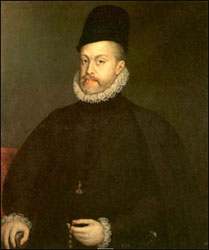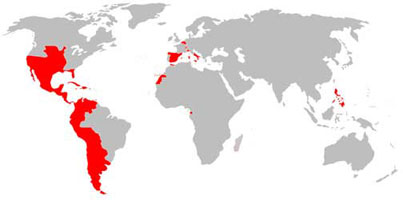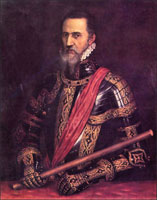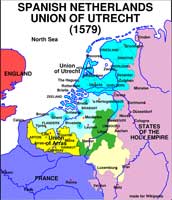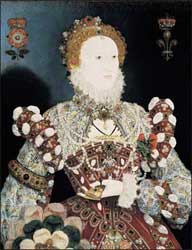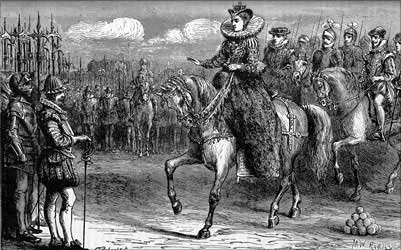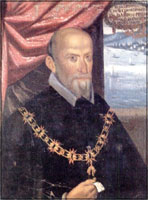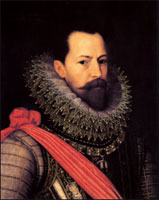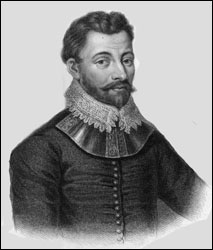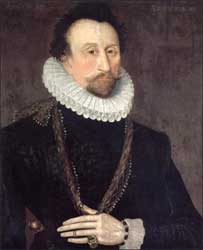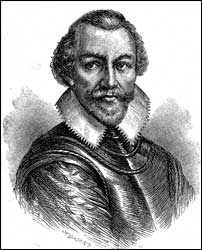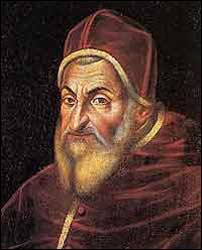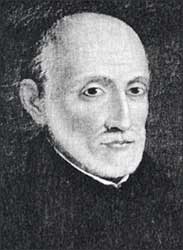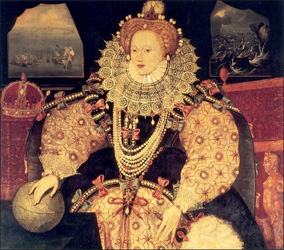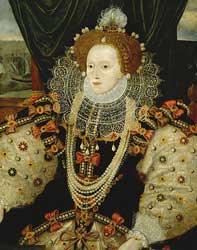| Defeat
of the "Invincible" Spanish Armada |
| "And
the king of Israel answered and said, Tell him, Let not him that girdeth
on his harness (armour) boast himself as he that putteth it off."
(I Kings 20:11). |
This year is the 420th anniversary of the destruction of the Spanish Armada (1588-2008).
The Spanish Empire of King Philip II
In the fateful year of 1588, the Spanish Empire was the largest the world had ever seen up to that time. It included ALL of the New World and a major part of Western Europe. Gold and silver (real money) was flowing into her coffers from the New World.
Philip II was the sole ruler of this vast domain. He was the most bigoted fanatic that ever counted beads or crossed himself before a crucifix....It was said that the only time he ever laughed was when he heard the report of the infamous St. Bartholomew's Day massacre of 100,000 Protestant Christians in France:
But nothing could exceed the satisfaction which the event occasioned in the mind of Philip the Second. There was an end now of all assistance from the French Government to the Netherlands Protestants. "The news of the events upon St. Bartholomew's Day," wrote the French envoy at Madrid, St. Goard, to Charles IX., "arrived on the 7th September. The King, on receiving the intelligence, showed, contrary to his natural custom, so much gaiety, that he seemed more delighted than with all the good fortune or happy incidents which had ever before occurred to him. He called all his familiars about him in order to assure them that your Majesty was his good brother, and that no one else deserved the title of Most Christian. He sent his secretary Cayas to me with his felicitations upon the event, and with the information that he was just going to St. Jerome to render thanks to God, and to offer his prayers that your Majesty might receive Divine support in this great affair. I went to see him next morning, and as soon as I came into his presence he began to laugh, and, with demonstrations of extreme contentment, to praise your Majesty as deserving your title of Most Christian, telling me there was no King worthy to be your Majesty's companion, either for valour or prudence. He praised the steadfast resolution and the long dissimulation of so great an enterprise, which all the world would not be able to comprehend..."
"I thanked him," continued the ambassador, "and I said that I thanked God for enabling your Majesty to prove to his Master that his apprentice had learned his trade, and deserved his title of Most Christian King. I added, that he ought to confess that he owed the preservation of the Netherlands to your Majesty. (The Rise of the Dutch Republic, vol. II, p. 483).
The Spanish Empire in the Netherlands
In 1567, Philip II dispatched a ruthless soldier named the Duke of Alva, with 12,000 men, to subjugate the Netherlands, and use it as a springboard to conquer England.
Throughout Europe, the Spanish army was notorious for their ferocity and ruthlessness. It had taken them over 700 years to drive the Moors from Spain . . . and suddenly they were the most feared army in the world!!
|
Duke of Alva (1507-1582). |
The Netherlands was ideally situated for an invasion of England. |
The Spanish Netherlands. |
This "Iron Duke" as he was called began a 6 year reign of terror in the Netherlands. On August 22, Alba, accompanied by a body of select Spanish troops, made his entry into Brussels. He immediately appointed a council to condemn without trial those suspected of heresy and rebellion. On June 1, 1568, Brussels witnessed the simultaneous decapitation of twenty-two noblemen; on 6 June followed the execution of the Counts of Egmond and Horne. The "Council of Blood" was the popular designation of Alba's tribunal.
The defeat of the "Invincible" Armada
Only Protestant England, and the small Dutch Republic under William of Orange, stood in Spain's way of eventual world conquest. England had a small population of 4 million, and no overseas possessions.
England's queen at that time was Elizabeth I, daughter of King Henry VIII and Saint Anne Boleyn.
|
Elizabeth
I (1533-1603). |
Queen Elizabeth addressing her troops at Tilbury. |
During Elizabeth's reign, the Reformation was firmly established in her kingdom, and Philip II was determined to stamp it out no matter what the cost.
While the "Invincible" Armada was under construction, the dissembling King Philip II was constantly assuring Queen Elizabeth of his abiding concern for her welfare and the prosperity of her kingdom:
During the time that this unprecedentedly vast fleet was being built in the harbours of Spain, everything was done to conceal the fact from the knowledge of the English nation. It was meant that the bolt should fall without warning and crush it. In an age when there were hardly any postal communications, secrecy was more easily attainable than in our day; but the preparations were on far too vast a scale to remain unknown. The next attempt was to propagate a delusion touching the real destination of this vast armament. At one time it was given out that it was intended to sweep from the seas certain pirates that gave annoyance to Spain, and had captured some of her ships. It was next said that Philip meant to chastise certain unknown enemies on the other side of the Atlantic. All that craft and downright lying could do was done, to lay to sleep the suspicions of the people of England. Even the English agent at Madrid, with the Armada building as it were before his eyes, was induced to credit these fabulous explanations; for we find him writing home that there had recently been discovered richer mines in the New World than any heretofore known; but that these treasures were guarded by a gigantic race, which only this enormous fleet could overcome; and this, he felt confident, was the true destination of the Armada. Even Walsingham, one of the most sagacious of the queen's ministers, expressed his belief just fifteen days before the Armada sailed that it never would invade England, and that Philip's hands were too full at home to leave him leisure to conquer kingdoms abroad. Such being the belief of some of her ambassadors and statesmen, it is not surprising that Elizabeth should have continued to confide in the friendly intentions of the man who was toiling night and day to prepare the means of her destruction, and could with difficulty be roused to put herself and kingdom in a proper posture of defence against the coming blow. (Wylie, History of Protestantism, vol. II, p. 448).
On May 28th 1588, the Armada, with around 130 ships, 8,000 sailors and 18,000 soldiers, 1,500 brass guns and 1,000 iron guns, set sail from Lisbon, Portugal, headed for the English Channel. An army of 30,000 men stood in the Spanish Netherlands, waiting for the fleet to arrive. The plan was to land the original force in Plymouth and transfer the land army to somewhere near London, mustering 55,000 men, a huge army for this time. The English fleet was prepared and waiting in Plymouth for news of Spanish movements. It took until May 30 for all of the Armada to leave port and, on the same day, Elizabeth's ambassador to the Netherlands, Dr Valentine Dale, met Parma's representatives to begin peace negotiations. On July 17, negotiations were abandoned.
|
The Duke of Medina Sidonia (1550-1615), led the "Invincible" Armada. |
My
brother Don Juan To England has gone To kill the Drake And the Queen to take And the heretics all to destroy |
The Duke of Parma (1545-1592), led the invasion force in the Netherlands. |
The basic plan of the "Invincible" Armada was to sail up the English Channel and rendezvous with the Duke of Parma in the Netherlands. Then the combined fleets would cross the Channel and the invasion of England would be a cakewalk. . . or so they planned.
The ships were filled with fanatical Jesuits . . . and racks, pulleys, thumbscrews, iron virgins, gridirons and other diabolical instruments of torture to be used once the Spanish Inquisition was set up in England.
The much smaller English ships were commanded by brave sea captains like Admiral Sir John Hawkins, Lord Thomas Howard, Sir Martin Frobisher and Sir Francis Drake.
Sir Francis Drake (1540-1596). |
Sir John Hawkins (1532-1595). |
Sir Martin Frobisher (1535-1594). |
Sir Francis Drake (called El Draque "the Dragon") by the Spanish Inquisition was just one of the many heroes of the destruction of the Spanish Armada....Sir Francis made a round the world voyage beginning in 1577 and in 1579 he landed in San Francisco Bay and claimed that land for his sponsor, Queen Elizabeth I....He named the land (now called California) Nova Albion—Latin for New Britain.
From the very beginning, disaster struck the "Invincible" Armada....The huge towering Spanish galleons were attacked by the smaller, nimbler English ships. When the Spanish fleet lay anchored at the French port of Calais, the English sent fire ships and caused a general panic among the Spanish fleet. Then the Almighty blew with His wind and drove them up toward Scotland and away from England.
God worked a stupendous MIRACLE for Protestant England by sending a FIERCE STORM which destroyed most of the ships.
Pope Sixtus V was delighted with the destruction of the "Invincible" Armada!!
Believe it or not, the reigning White Pope, Sixtus V, greatly admired the courage and intelligence of Queen Elizabeth and even wished he could marry her. Here is a quote from a pro-Spanish English writer:
In Rome the shrewd, vigorous, tactless, uneducated Sixtus had just succeeded his old enemy Gregory as Pope. He greeted the news of Mary's death with lamentation, but added in an aside about Elizabeth: 'What a valiant woman—she braves the two greatest kings by land and sea. A pity we cannot marry, she and I, for our children would have ruled the world!' To the Spanish Ambassador he repeated his promise to give Philip one million ducats as soon as Spanish soldiers landed on English soil, but would not advance a single one by way of a forward loan. (Graham, The Spanish Armadas, p. 67).
When news of the doomed Armada finally reached Rome, Pope Sixtus refused to pay the promised one million ducats (about 1 billion dollars or 1/6 of the cost of the Armada). A satire or lampoon was posted in Rome about the Pope's attitude to the loss of the Armada:
When the news of the Armada's failure arrived in Rome, there was posted up a pasquilade, in which Sixtus was made to offer, out of the plenitude of his power, a thousand years' indulgence to anyone who would give him information respecting the whereabouts of the Spanish fleet: whether it had been taken up into heaven, or had descended into hell; whether it was hanging in mid air, or was still tossing on the ocean. (Wylie, History of Protestantism, vol. II, p. 460).
|
Pope Sixtus
V (1521-1590). |
|
Jesuit general
Claudius Aquaviva. |
Obviously Philip II was FURIOUS over this satire and especially the refusal of the Pope to pay the promised ducats....He ordered Black Pope Claudius Aquaviva to poison Pope Sixtus and replace him with a more compliant Pope. Being Pope at that time was more dangerous than sailing with the Armada.
This order was carried out in August 1590, and in that year 3 Popes were assassinated: Sixtus V, Pope Urban VII and Gregory XIV....We have to wait until 1978 to see 3 Popes in one single year,and 2 of them were poisoned to make way for Pope John Paul II.
Until his death in 1598, Philip actually went through 5 White Popes because none of them would come up with any money to finance the 3 more Armadas that he launched against England.
Queen Elizabeth's Armada portrait
As can be expected, the joy in England and among all the Protestant Christians of Europe for God's great deliverance was unbounded....The link between this deliverance and the overthrow of Pharaoh—the ancient persecutor of God's people—was obvious to all who had eyes to see:
Then sang Moses and the children of Israel this song unto the LORD, and spake, saying, I will sing unto the LORD, for he hath triumphed gloriously: the horse and his rider hath he thrown into the sea.
The enemy said, I will pursue, I will overtake, I will divide the spoil; my lust shall be satisfied upon them; I will draw my sword, my hand shall destroy them.
Thou didst blow with thy wind, the sea covered them: they sank as lead in the mighty waters. (Exodus15:1-10).
|
|
National Portrait Gallery version. |
Portrait of Queen Elizabeth painted soon after the defeat of the "Invincible" Armada. In the left background can be seen the English fleet and the Spanish Armada is on the rocks to the right.
Pearls—symbolic of purity—decorate the queen's head and gown. Next to her right arm is an imperial crown, and her right hand rests upon a globe—specifically, her fingers rest upon the New World.
This symbolized the fact that Protestant England would rule the waves from then onward and the English would ignore the FRAUDELANT Bull of Pope Alexander VI and begin to colonize the New World.
Editor's Notes
3 more Armadas were launched against England after 1588. The second left Spain in October 1596, with instructions to land in Ireland. Another violent storm wrecked most of the ships.
The third Armada left Spain the following year but it was also destroyed by storms.
The fourth and last Armada left Spain in February 1598, to rendezvous with French troops at Calais, but the death of Philip II put an end to further Spanish attempts to invade England.
References
Graham, Winston. The Spanish Armadas. Doubleday & Co., Garden City, New York, 1972.
Motley, John Lothrop. The Rise of the Dutch Republic. (In 2 volumes). George Allen & Unwin Ltd., London, 1889.
Wylie, Dr. J.A. History of Protestantism. (In 2 volumes). Cassell Petter & Galpin, London, 1875.
Copyright © 2007 by Niall Kilkenny
